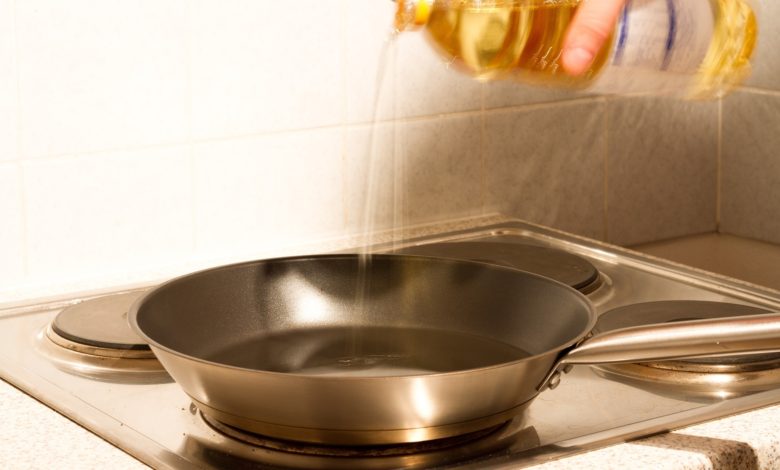What is Smoke Point in Oils, Why Is It Important?

The smoke point of frying oils refers to the temperature an oil will reach before its boiling point. Heating oils that exceed their boiling point have been associated with the buildup of carcinogens and may also produce a burnt, bitter taste. Knowing the difference between fats and smoke spots is an essential part of healthy cooking. Each oil has a different smoke point, depending on whether the oil has been refined and what percentage of polyunsaturated and monounsaturated and saturated fats. This article contains information about the smoke point of oils.
Is it Harmful to Consume the Oil that Passes the Smoke Point?
The smoke generated when an oil reaches its smoke point is an indication that the oil has deteriorated. In general, as a general rule, the smoke point tends to increase the more refined an oil is and the lower the free fatty acid content. As the oil is heated, more free fatty acids are produced which lower the smoke point. It is generally recommended not to use the frying oil more than twice. The main reason for this is this increase in free fatty acid formation and harmful free radicals each time the oil is heated by a process called oxidation. This is a series of chemical reactions involving oxygen that degrade the oil and cause rancidity.
In fact, there is a way to measure how much an oil degrades by measuring the concentration of these byproducts called polar compounds. Polar compounds are affected, among other things, by the moisture content of the food that interacts with the cooking oil, the surface area, and how many residual particles are left in the cooking oil. However, studies show a correlation between oils highest in polyunsaturated fats (PUFAs) and high production of polar compounds when heated. This is one reason why eating deep-fried foods is not only unhealthy in terms of calorie content. These foods may actually contain toxic carcinogenic compounds if they are cooked in oil that is repeatedly heated, and especially in oil with high PUFAs. Reheating oil also breaks down beneficial polyphenol antioxidants, one of the most important health benefits of plant-based oils. Repeated heating of oils, especially polyunsaturated fats, at high temperatures beyond the smoke points can lead to the formation of carcinogenic compounds.
What Are The Best Oils For Cooking?
There are a few points to consider when determining the right cooking oil: nutritional value, flavor and cooking technique. Knowing the smoke point of an oil provides further information to help determine what types of oils are best for cooking methods in particular. However, the most important thing to remember is not to heat and reheat polyunsaturated oils beyond smoke spots, as these are oils that are most prone to oxidation and produce the most harmful compounds when oxidized. When choosing a good oil, it is necessary to consider the following factors:
Nutritive value
The best oils for overall health are those that are high in monounsaturated and polyunsaturated fats. These oils are known to be cardioprotective and reduce systemic inflammation in the body. Monounsaturated oils include canola oil, peanut oil, almond oil, olive oil, avocado oil, and high oleic sunflower and safflower oil. Polyunsaturated oils include wheat germ oil, soybean oil, sunflower oil, safflower oil, grape seed oil, walnut oil, linseed oil and corn oil. Sesame oil has nearly equal proportions of monounsaturated and polyunsaturated fats (about 40% each).
Oils can be bottled or refined and processed immediately after extraction or pressing. Oils left in their natural state are labeled unrefined, cold pressed, raw or unprocessed and processed without any chemical solvent. These oils tend to have better nutrient retention and higher polyphenol contents. These unrefined oils also tend to have lower smoke points and can deteriorate more quickly, so understanding smoke points and storing them properly is imperative.
Olive oil in particular is known for its high polyphenol levels; These are highest in natural extra virgin olive oil, which is one of the reasons why it was touted as it is so healthy. In fact, for an oil to be referred to as leaking, it must meet certain minimum polyphenol concentrations. Yet even among extra virgin olive oils, the polyphenol content can vary significantly depending on the climatic conditions in the olive groves, when the olives are harvested, how mature when they are collected, and how the oil is produced and stored.
The taste of oils varies considerably. Most unrefined expeller pressed and cold pressed plant-based oils will have distinctive aromas, but some are stronger than others. For example, nut and seed oils such as walnuts, almonds, walnuts, pumpkin seeds and sesame oils, especially fried varieties, are used especially for their taste as they have strong aromas similar to the nut from which they were derived. Another category of oils that cooks often refer to as neutral oils do not have a strong flavor and are mainly used for an oil function in cooking, such as sautéing, frying or caramelizing or using it in frying. Some neutral oils are also commonly used in salad dressing if the recipe contains other strong flavors and uses mainly oil for emulsification, such as a mayonnaise-based sauce. Neutral oils include canola oil, grapeseed oil, corn oil, and avocado oil.
High-quality extra olive oil should have a fruity, bitter or even pungent taste, depending on the type, origin and processing of the olive used. Normal extra virgin and light olive oils are either a mixture of cold pressed and refined oils, or fully refined by a processing method that uses heat and has a more neutral flavor and slightly higher smoke points.
Cooking Technique
Oils can be bottled or refined and processed immediately after extraction or pressing. Oils left in their natural state are labeled as unrefined, cold pressed, raw or unrefined. These oils tend to retain the flavors and all the nutrients found in them. However, in terms of cooking, unrefined oils tend to have lower smoke points, oxidize more easily when heated, and are more likely to become mildew if not stored properly; These oils are best used for raw applications such as very low heat cooking such as baking or light sautéing, salad dressings or finishing drizzle.
The biggest exceptions to this are extra virgin olive oil and unrefined avocado oil, which naturally have higher smoke points and are more stable when heated due to their high monounsaturated fat content. They do not produce the same volatile carcinogenic compounds when broken down like oils high in polyunsaturated fat. If oils are refined or processed, they will usually be extracted using chemical solvents and also heated to remove volatile compounds that break down and lead to rapid oxidation of unrefined oils. As a result, these refined oils are less flavorful, have a longer shelf life and higher smoke points.
As a general rule, it is generally recommended to use oils with high smoke points (greater than 400F) during frying or cooking at very high temperatures. These oils include refined oils (refined canola oil, coconut oil, peanut oil, avocado oil, corn oil, etc., as well as light olive oil and some fats such as ghee (plain butter) and lard. These oils are also ideal for roasting because Made at temperatures between 375F-450F, however, sautéing, frying at just 375F, or pan-frying at temperatures below 400F, using olive oil or extra virgin olive oil for its numerous health benefits and taste is an excellent result! Another oil high in monounsaturated fats. Avocado oil is also an excellent choice if you’re looking for a neutral-flavored oil with excellent health benefits.
What is the Difference between Cold Press and Expeller Press?
Neither expeller nor cold press use high heat or chemicals as an extraction method. Expeller compressed oil is oil extracted using a screw press that compresses seeds and nuts through a cavity and uses friction and pressure to extract the oil. Although heat is not added, some natural heat is generated from friction (about 210F). Cold pressed oil is extracted using an oilseed press that crushes nuts and seeds. This is done at a very low temperature (around 120F), and proponents of cold pressed oils claim that it is an ideal method for maintaining maximum flavor and nutritional value. Both processes are more costly for oil producers because they do not produce oil at high yields, so many oils are pressed using chemical solvents and other methods with high heat, and this is also why cold pressed oils have higher prices.
After all, all oils contain a combination of both polyunsaturated and monounsaturated fats. Fats high in polyunsaturated fat are healthier than consuming large amounts of saturated fat. However, when cooking at higher temperatures and selecting an oil for regular use, it may be wise to opt for oils with higher smoke points, which are both higher in monounsaturated fats and less degradation when heated.





